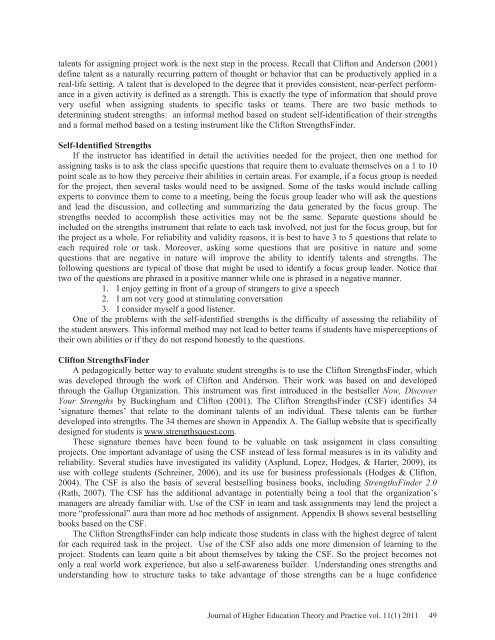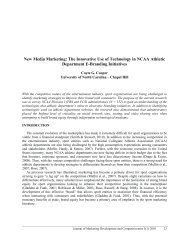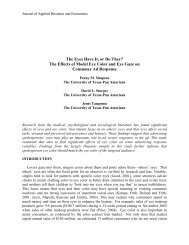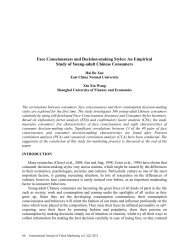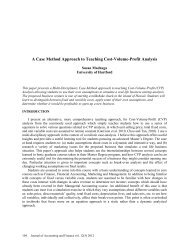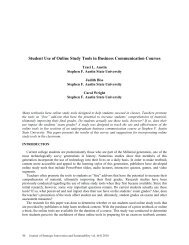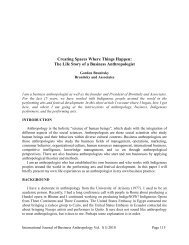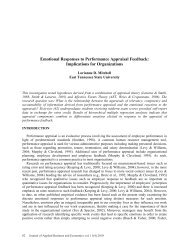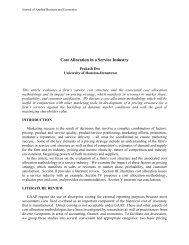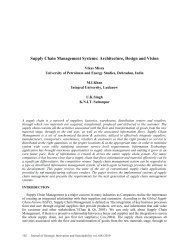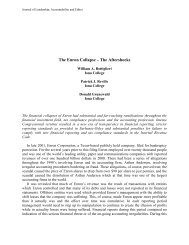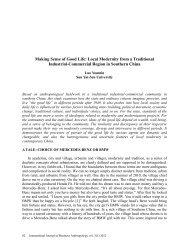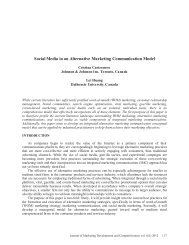Steger, Mankin, Jewell
Steger, Mankin, Jewell
Steger, Mankin, Jewell
You also want an ePaper? Increase the reach of your titles
YUMPU automatically turns print PDFs into web optimized ePapers that Google loves.
talents for assigning project work is the next step in the process. Recall that Clifton and Anderson (2001)<br />
define talent as a naturally recurring pattern of thought or behavior that can be productively applied in a<br />
real-life setting. A talent that is developed to the degree that it provides consistent, near-perfect performance<br />
in a given activity is defined as a strength. This is exactly the type of information that should prove<br />
very useful when assigning students to specific tasks or teams. There are two basic methods to<br />
determining student strengths: an informal method based on student self-identification of their strengths<br />
and a formal method based on a testing instrument like the Clifton StrengthsFinder.<br />
Self-Identified Strengths<br />
If the instructor has identified in detail the activities needed for the project, then one method for<br />
assigning tasks is to ask the class specific questions that require them to evaluate themselves on a 1 to 10<br />
point scale as to how they perceive their abilities in certain areas. For example, if a focus group is needed<br />
for the project, then several tasks would need to be assigned. Some of the tasks would include calling<br />
experts to convince them to come to a meeting, being the focus group leader who will ask the questions<br />
and lead the discussion, and collecting and summarizing the data generated by the focus group. The<br />
strengths needed to accomplish these activities may not be the same. Separate questions should be<br />
included on the strengths instrument that relate to each task involved, not just for the focus group, but for<br />
the project as a whole. For reliability and validity reasons, it is best to have 3 to 5 questions that relate to<br />
each required role or task. Moreover, asking some questions that are positive in nature and some<br />
questions that are negative in nature will improve the ability to identify talents and strengths. The<br />
following questions are typical of those that might be used to identify a focus group leader. Notice that<br />
two of the questions are phrased in a positive manner while one is phrased in a negative manner.<br />
1. I enjoy getting in front of a group of strangers to give a speech<br />
2. I am not very good at stimulating conversation<br />
3. I consider myself a good listener.<br />
One of the problems with the self-identified strengths is the difficulty of assessing the reliability of<br />
the student answers. This informal method may not lead to better teams if students have misperceptions of<br />
their own abilities or if they do not respond honestly to the questions.<br />
Clifton StrengthsFinder<br />
A pedagogically better way to evaluate student strengths is to use the Clifton StrengthsFinder, which<br />
was developed through the work of Clifton and Anderson. Their work was based on and developed<br />
through the Gallup Organization. This instrument was first introduced in the bestseller Now, Discover<br />
Your Strengths by Buckingham and Clifton (2001). The Clifton StrengthsFinder (CSF) identifies 34<br />
‘signature themes’ that relate to the dominant talents of an individual. These talents can be further<br />
developed into strengths. The 34 themes are shown in Appendix A. The Gallup website that is specifically<br />
designed for students is www.strengthsquest.com.<br />
These signature themes have been found to be valuable on task assignment in class consulting<br />
projects. One important advantage of using the CSF instead of less formal measures is in its validity and<br />
reliability. Several studies have investigated its validity (Asplund, Lopez, Hodges, & Harter, 2009), its<br />
use with college students (Schreiner, 2006), and its use for business professionals (Hodges & Clifton,<br />
2004). The CSF is also the basis of several bestselling business books, including StrengthsFinder 2.0<br />
(Rath, 2007). The CSF has the additional advantage in potentially being a tool that the organization’s<br />
managers are already familiar with. Use of the CSF in team and task assignments may lend the project a<br />
more “professional” aura than more ad hoc methods of assignment. Appendix B shows several bestselling<br />
books based on the CSF.<br />
The Clifton StrengthsFinder can help indicate those students in class with the highest degree of talent<br />
for each required task in the project. Use of the CSF also adds one more dimension of learning to the<br />
project. Students can learn quite a bit about themselves by taking the CSF. So the project becomes not<br />
only a real world work experience, but also a self-awareness builder. Understanding ones strengths and<br />
understanding how to structure tasks to take advantage of those strengths can be a huge confidence<br />
Journal of Higher Education Theory and Practice vol. 11(1) 2011 49


